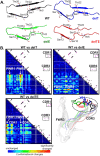The role of Antibody Vκ Framework 3 region towards Antigen binding: Effects on recombinant production and Protein L binding
- PMID: 28630463
- PMCID: PMC5476676
- DOI: 10.1038/s41598-017-02756-3
The role of Antibody Vκ Framework 3 region towards Antigen binding: Effects on recombinant production and Protein L binding
Abstract
Antibody research has traditionally focused on heavy chains, often neglecting the important complementary role of light chains in antibody formation and secretion. In the light chain, the complementarity-determining region 3 (VL-CDR3) is specifically implicated in disease states. By modulating VL-CDR3 exposure on the scaffold through deletions in the framework region 3 (VL-FWR3), we further investigated the effects on secretion in recombinant production and antigen binding kinetics. Our random deletions of two residues in the VL-FWR3 of a Trastuzumab model showed that the single deletions could impact recombinant production without significant effect on Her2 binding. When both the selected residues were deleted, antibody secretion was additively decreased, and so was Her2 binding kinetics. Interestingly, we also found allosteric effects on the Protein L binding site at VL-FWR1 elicited by these deletions in VL- FWR3. Together, these findings demonstrate the importance of light chain FWR3 in antigen binding, recombinant production, and antibody purification using Protein L.
Conflict of interest statement
The authors declare that they have no competing interests.
Figures



References
-
- Giudicelli V, Brochet X, Lefranc M. IMGT/V-QUEST: IMGT standardized analysis of the immunoglobulin (IG) and T cell receptor (TR) nucleotide sequences. Cold Spring Harb Protoc. 2011;2011:695–715. - PubMed
-
- Elgert, K. D. In Immunology - Understanding the Immune System (John Wiley & Sons, Inc., 1998).
Publication types
MeSH terms
Substances
LinkOut - more resources
Full Text Sources
Other Literature Sources
Research Materials
Miscellaneous

